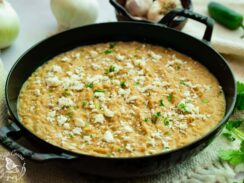Mexican Sopes
Mexican Sopes, also known as “pellizcadas” in various regions of Mexico, are a cherished traditional Mexican dish deeply rooted in the country’s culinary heritage. This beloved dish consists of a thick, cooked tortilla carefully molded to hold the most delicious toppings.
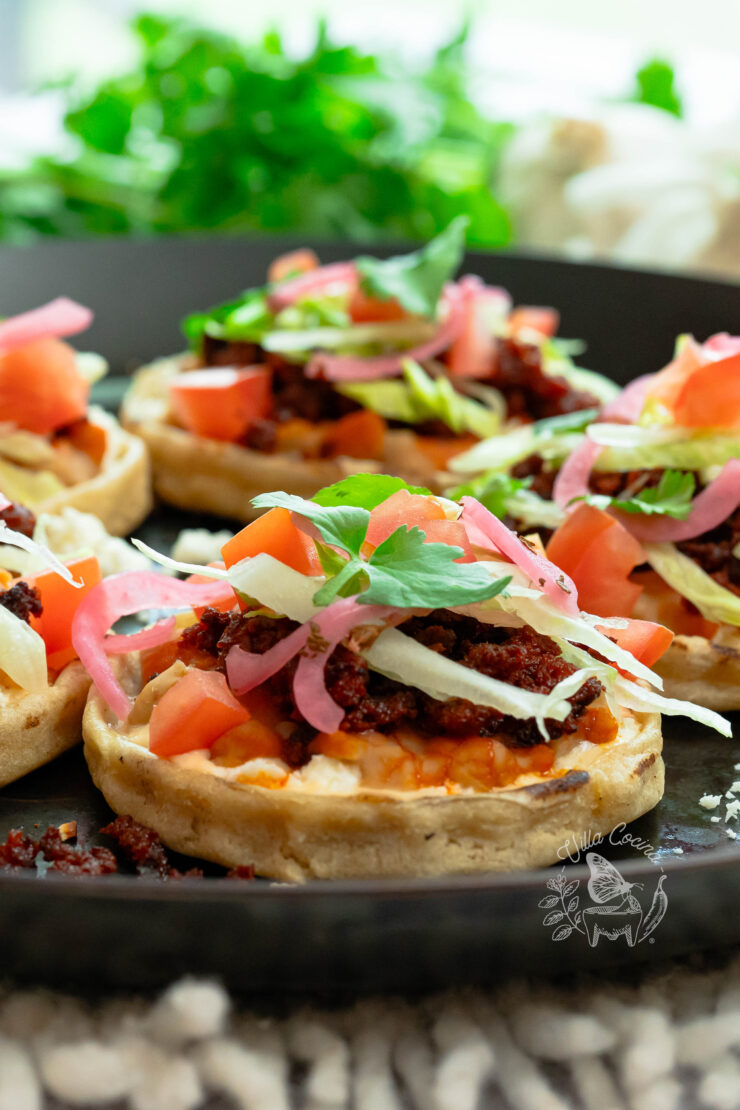
Classic combinations typically feature tender proteins like chicken, flavorful beef, or spicy chorizo, topped with a medley of textures and flavors, including creamy refried beans, crunchy lettuce, diced onions, cheese and a spicy salsa, all coming together to create a delightful and satisfying meal.
What are Sopes?
When Mexico comes to mind, Sopes are a classic favorite! The magic begins with just three essential ingredients: masa harina (corn that’s been nixtamalized and finely ground), water, and a pinch of salt.
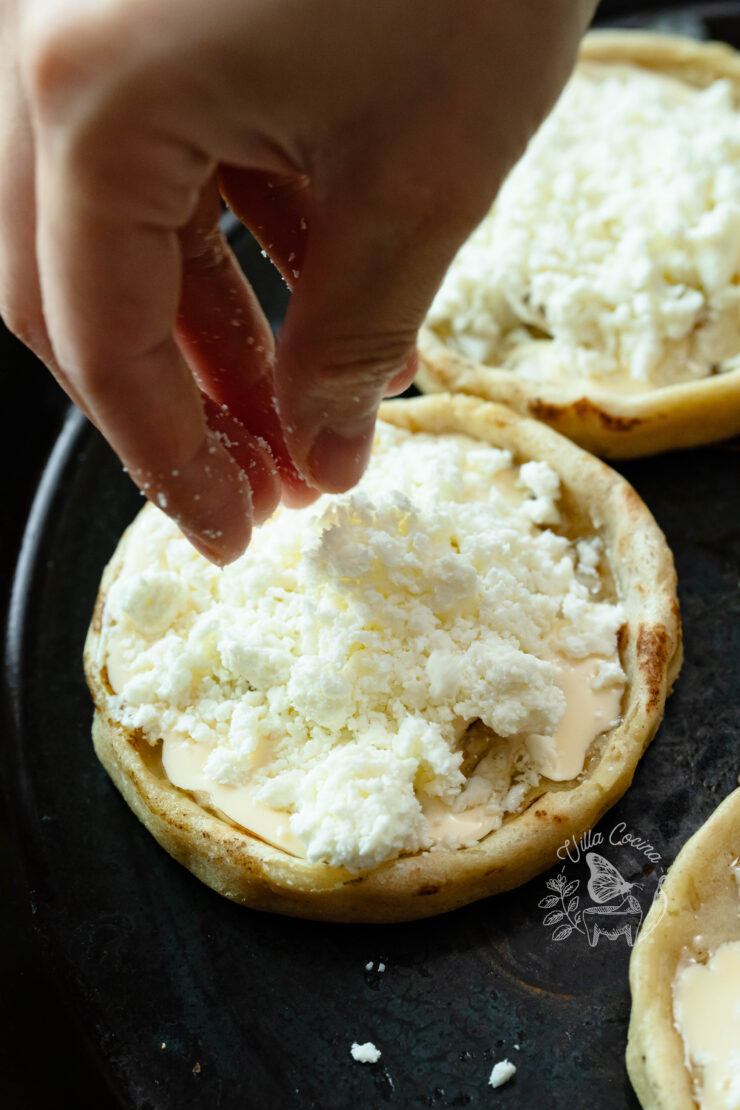
While traditional Sopes are hand-formed in Mexico, an art form in itself, modern techniques make it easier for the world to enjoy this delight. A tortilla press or the bottom of a flat plate can help shape the dough.
But here’s the twist: a Sope starts its life as a Gordita, molded similarly, then transforms into its signature bowl-like shape with a carefully crafted raised border. Afterward, it’s fried, cooked on a comal, or baked for a crispy finish. Toppings are carefully layered to create a visually appealing dish, and it’s ready to be served.
Sopes vs. Gorditas
For those who have grown up enjoying these traditional Mexican treats, the difference between sopes and gorditas is clear. While they share similarities in flavor, their preparation and textures set them apart.
A sope can start as a gordita, but it’s then molded into a shape that’s crispier and crunchier, perfect for holding delicious toppings. On the other hand, gorditas are meant to be stuffed, with a soft, doughy interior and a crispy exterior, making them ideal for filling with savory ingredients.
Whether you prefer the satisfying crunch of a sope or the comforting softness of a gordita, both are sure to satisfy your cravings!
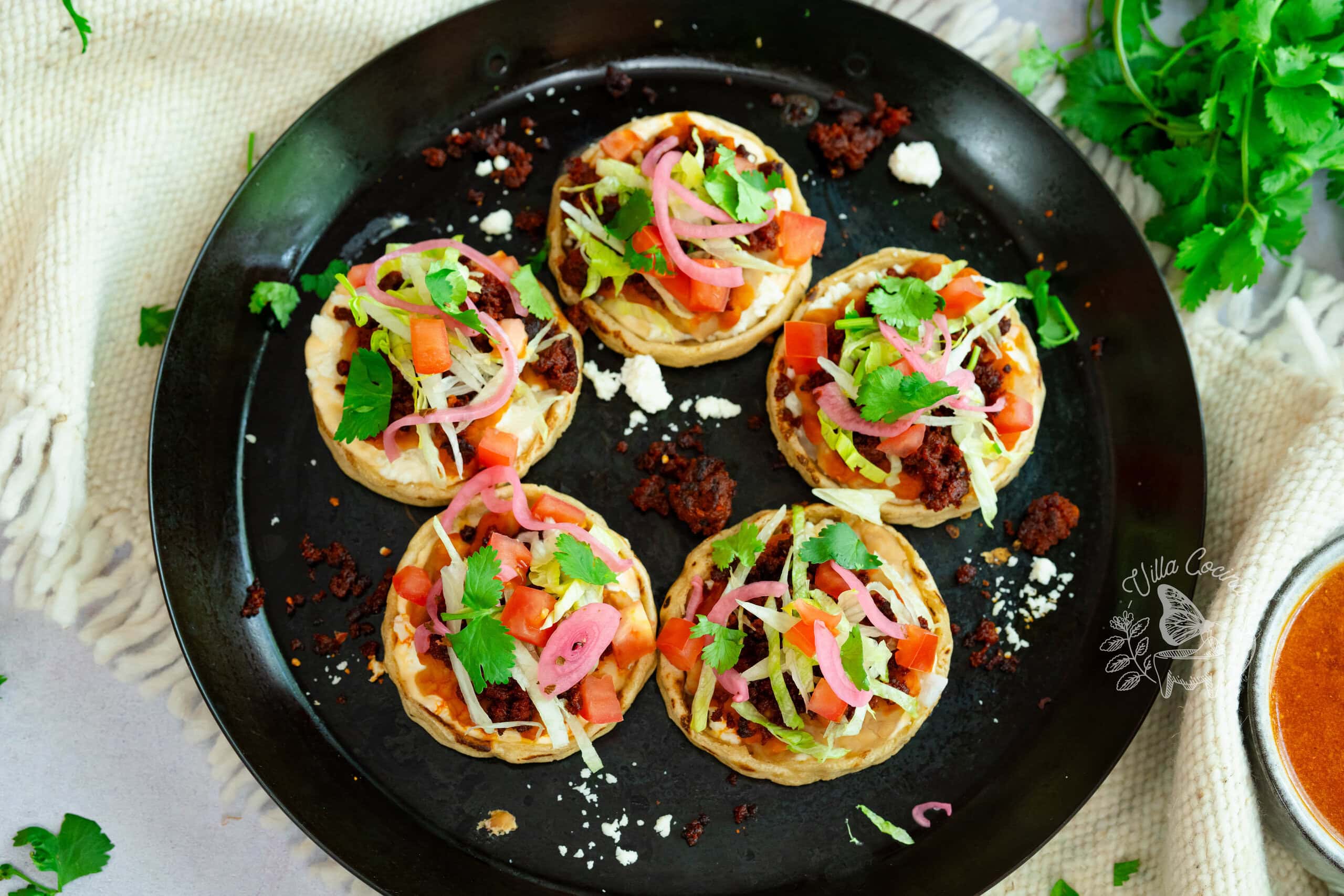
Ingredients
- Masa Harina is a special corn flour made from nixtamalized corn. The resulting flour is hydrated to form a pliable dough, perfect for making traditional Mexican dishes.
- Pork chorizo is a Mexican sausage seasoned with spices for a smoky, spicy flavor. It’s typically removed from its casing before cooking.
- Pork lard is a traditional ingredient in Mexican cuisine, adding depth of flavor and a tender, flaky texture to various dishes.
- White onions are slightly sweet with mild, subtle flavors that won’t overpower other ingredients.
- Crema Mexicana is Mexico’s sweeter, creamier version of sour cream. It’s rich, tangy, and perfectly balanced, with a heavy cream consistency, and made from cow’s milk.
- Queso Cotija is a type of Mexican cheese that’s crumbly in texture, milky in flavor, but has a saltier taste profile.
- Iceberg lettuce is mild, crisp, and has high water content. It’s easy to use, especially as a topping for sopes.
- Cilantro is bright, fruity, and citrusy.
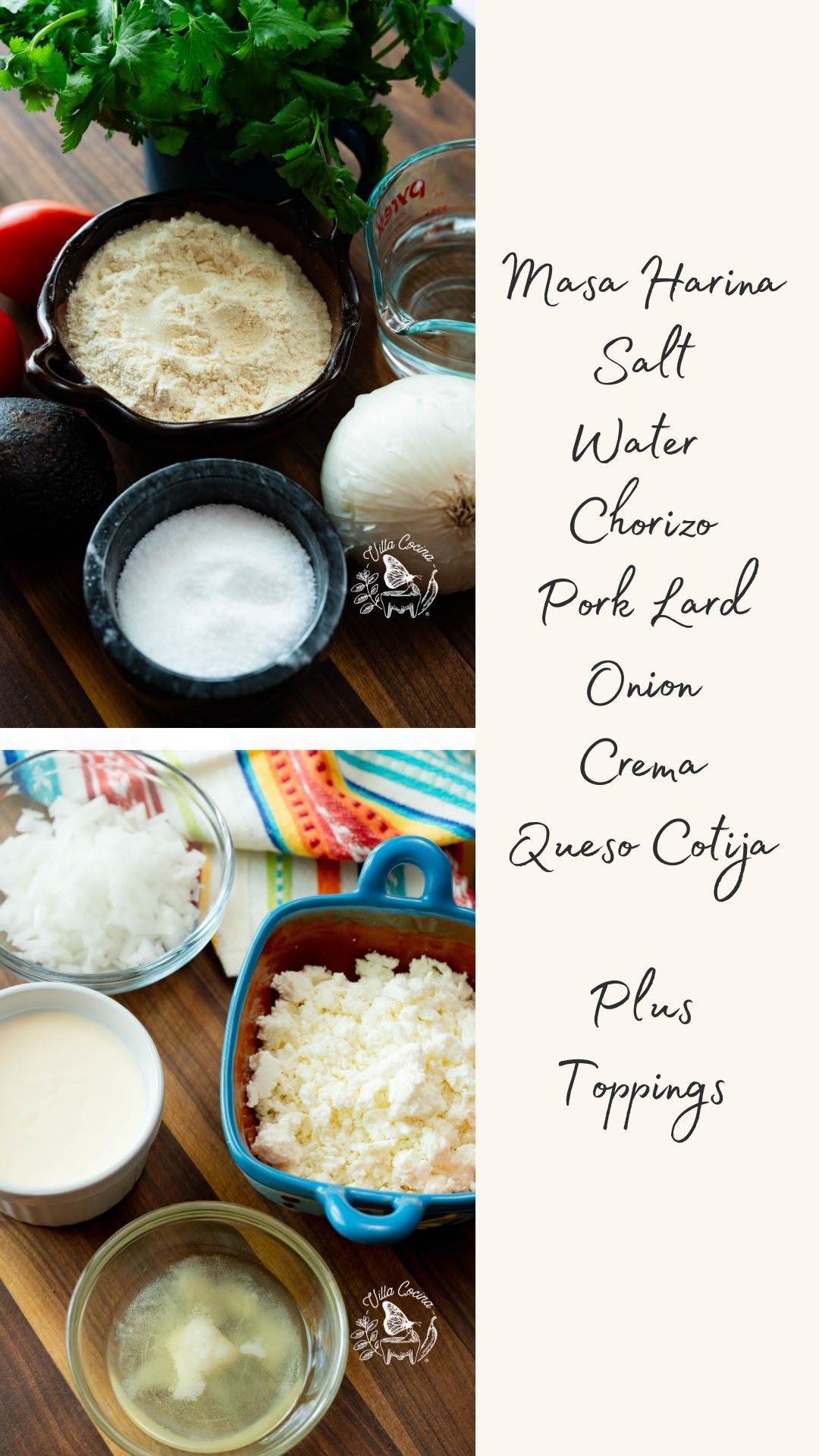
How to make sopes
Prepare the Masa
Combine masa harina and salt in a large bowl, mixing until well distributed. Gradually pour in the warm water while mixing in between additions with your hands.
Stop adding water when the dough feels smooth and supple, yet still holds its shape firmly without dry patches. Knead the dough for 3-5 minutes until smooth, hydrated, and pliable, but not sticky.
If the dough feels too dry and cracks, add a small amount of water to restore its pliability and flexibility.
On the other hand, if it’s too wet and sticky, mix in a bit more masa harina to absorb the excess moisture, allowing you to mold the sope with ease.
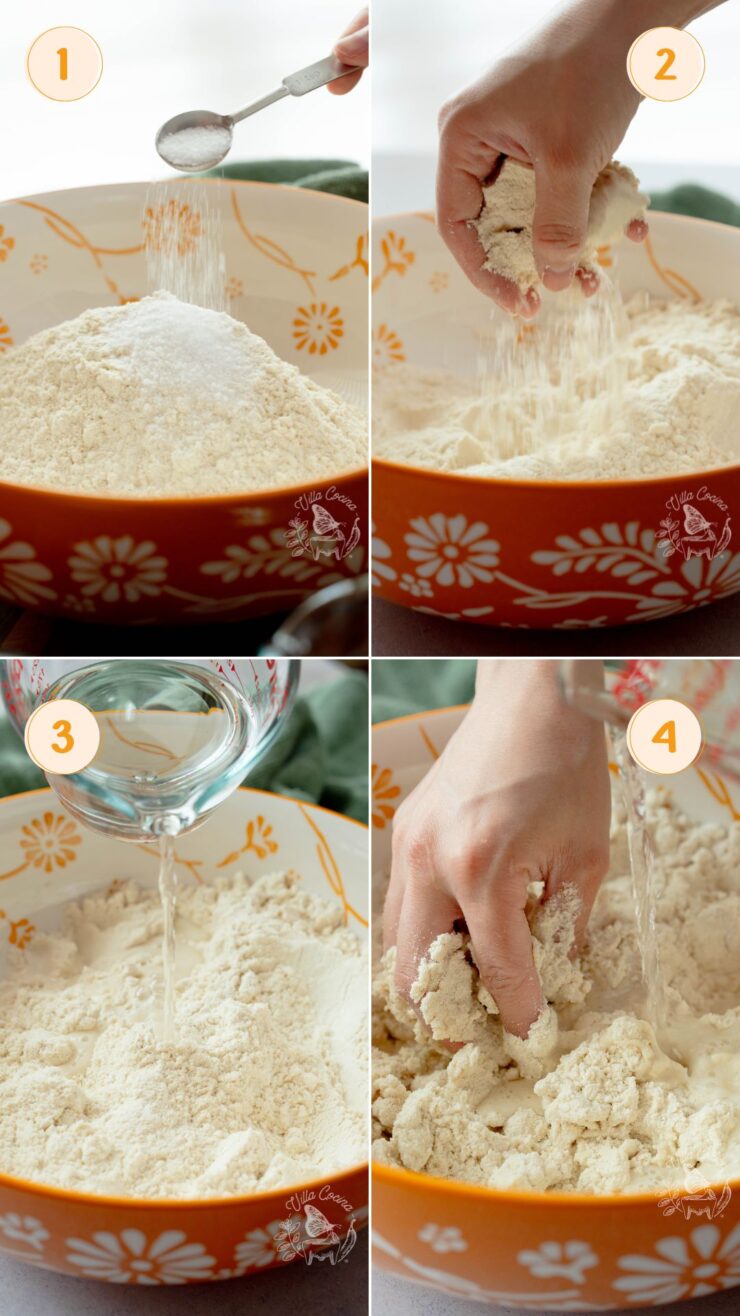
Cover with a clean kitchen towel or a damp paper towel.
Shape Sopes by Hand
Heat a comal, cast iron griddle, or non-stick pan over medium to medium-low heat. The heat should allow the thick tortilla to cook through and brown, without burning it.
Divide the dough into 10 equal balls, then flatten each one into a disk by applying gentle pressure and rocking it back and forth between your hands.
Continue this motion, rotating and pressing the masa, until you’ve shaped it into a 1/4-inch thick tortilla. If necessary, smooth the edges with your fingers. (Scroll down for instructions for molding the sopes using a tortilla press or plate)
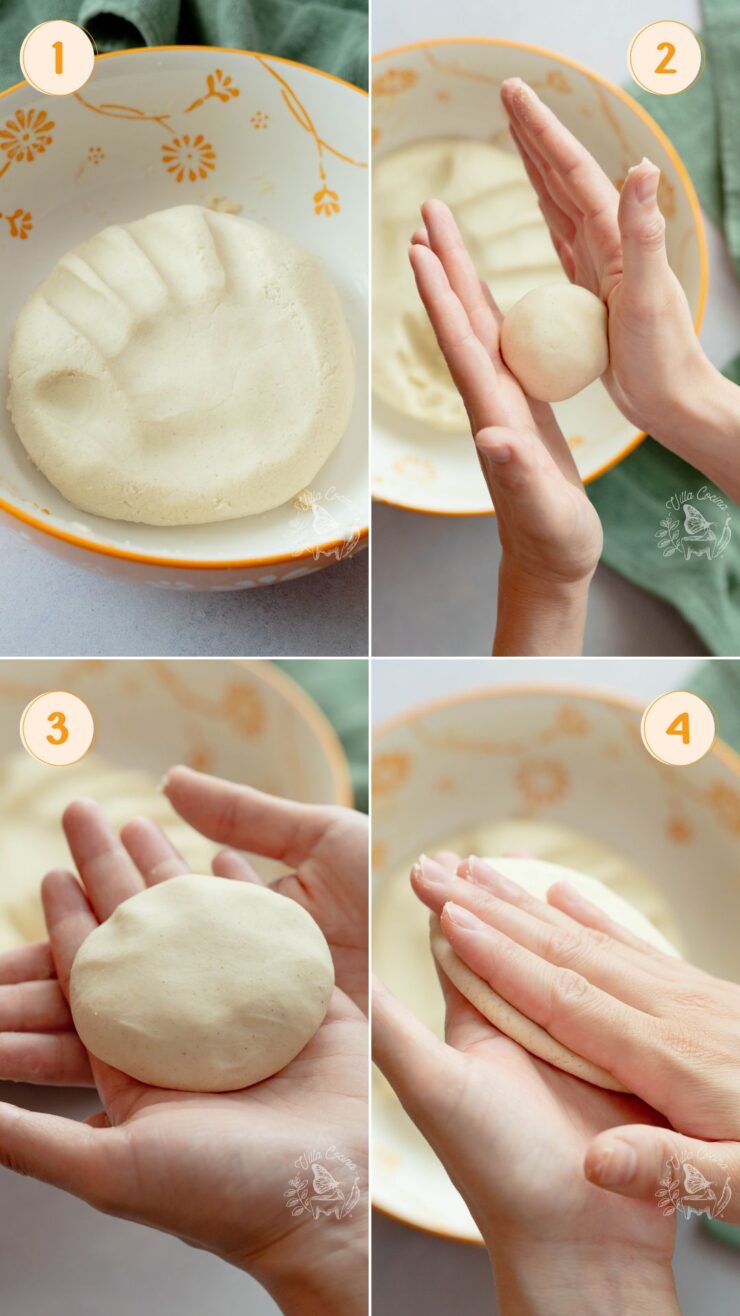
As you mold each sope, you can either cook it immediately or set it aside to cook all of them later.
If you choose later, place the molded sopes on a sheet pan lined with parchment paper. Cover them with plastic wrap to prevent them from drying out.
Cook the Sopes
To cook the sopes, start by placing as many as you can on the preheated comal or griddle. Let them cook on the first side, until the bottoms release and develop golden brown spots.
Flip them over and cook the other side until equally browned. If needed, flip them multiple times to achieve even cooking and browning.
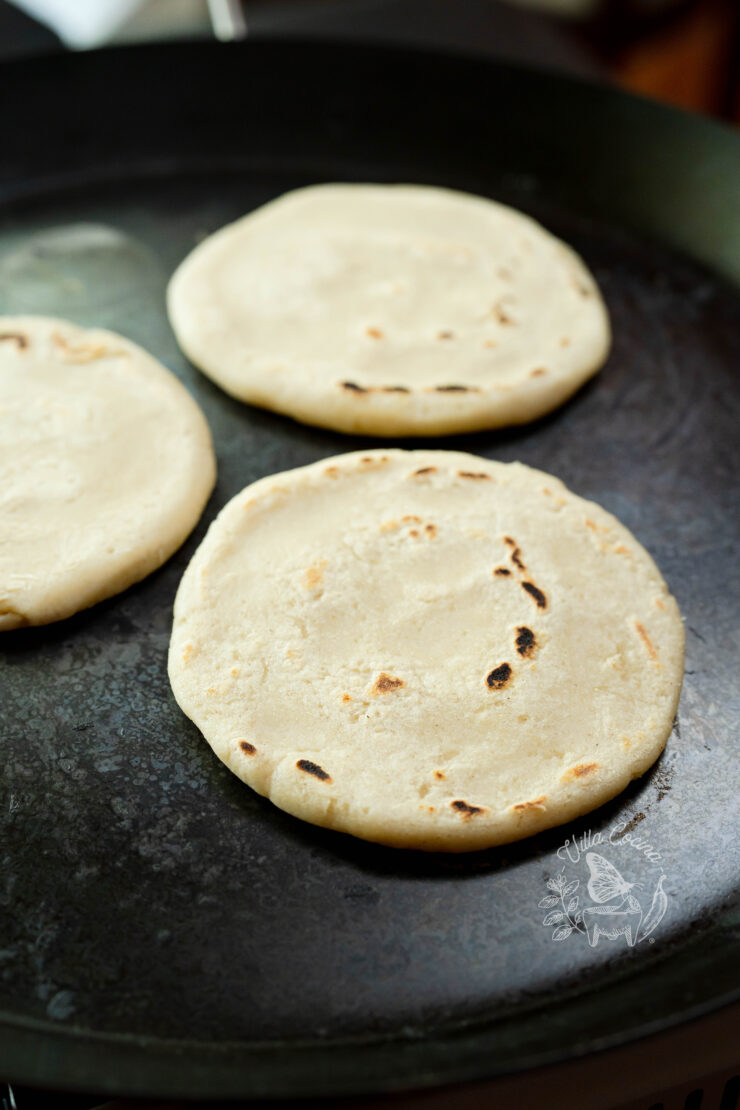
Once cooked, remove the sopes from the heat and let them cool slightly while you continue to cook the remaining ones.
Mold The Sopes
To shape the sopes, work with them while they’re still hot, as this will make them easier to mold.
Wrap your fingers with a kitchen towel to protect them from the heat, then pinch the edges of each sope to create a border. Next, pinch the middle of the sope, taking care not to tear it.
Finally, once cool enough to handle, refine the edges with your bare fingers to achieve a more uniform shape. Once all the bases are formed, keep them covered.
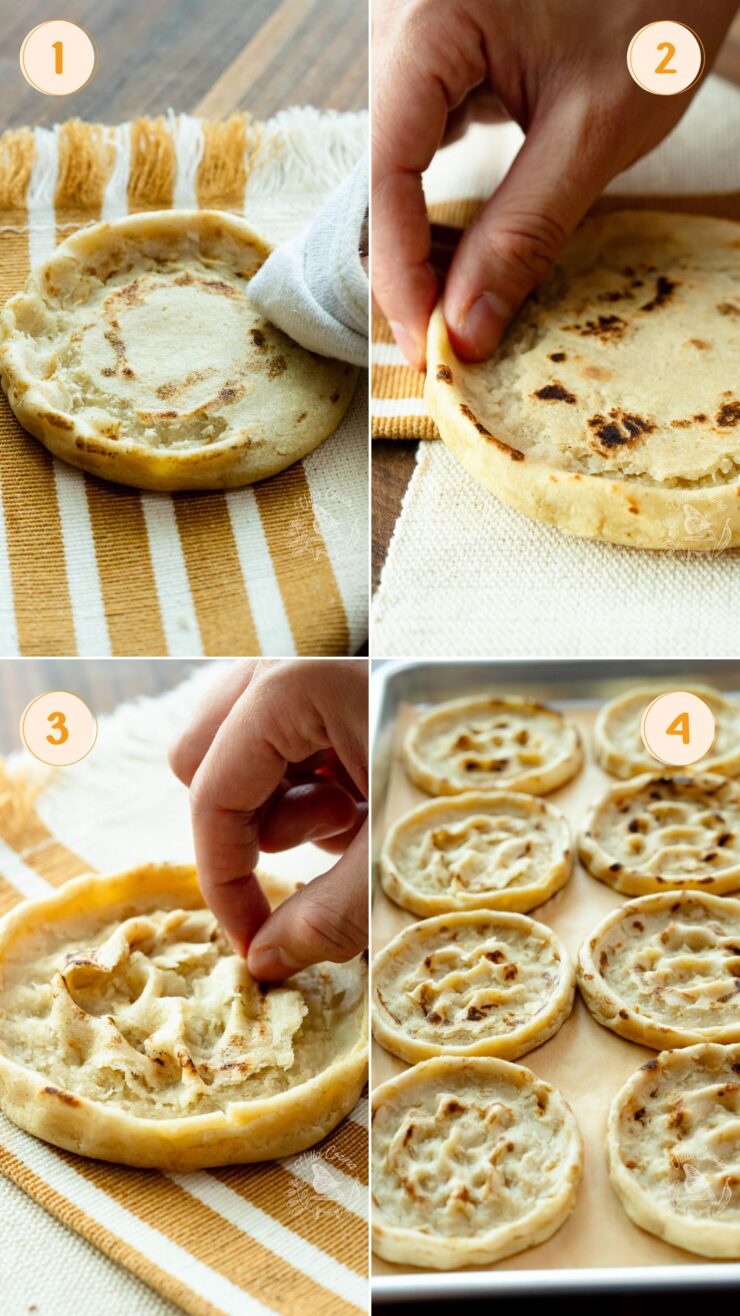
Protein
Cook the chorizo in a large non-stick pan over medium heat, stirring occasionally, until fully cooked and crispy. Set aside momentarily.
Assemble Sopes
Heat a comal or non-stick pan over medium heat. Arrange as many sopes as possible on the hot surface, then add 1 teaspoon of lard and 1 tablespoon of chopped onion. If the bottoms start to get too dark, reduce the heat to prevent burning, allowing them to crisp up.
Once the fat starts to lightly sizzle (about 5 minutes), drizzle 1-2 tablespoons of crema onto the center of each sope. Top with a generous sprinkle of crumbled cotija cheese and continue cooking until the crema bubbles and the cheese softens, creating a cheesy sauce.
As the sopes become ready, remove them from the heat and plate them. Spread a layer of refried beans on each one, and chorizo.
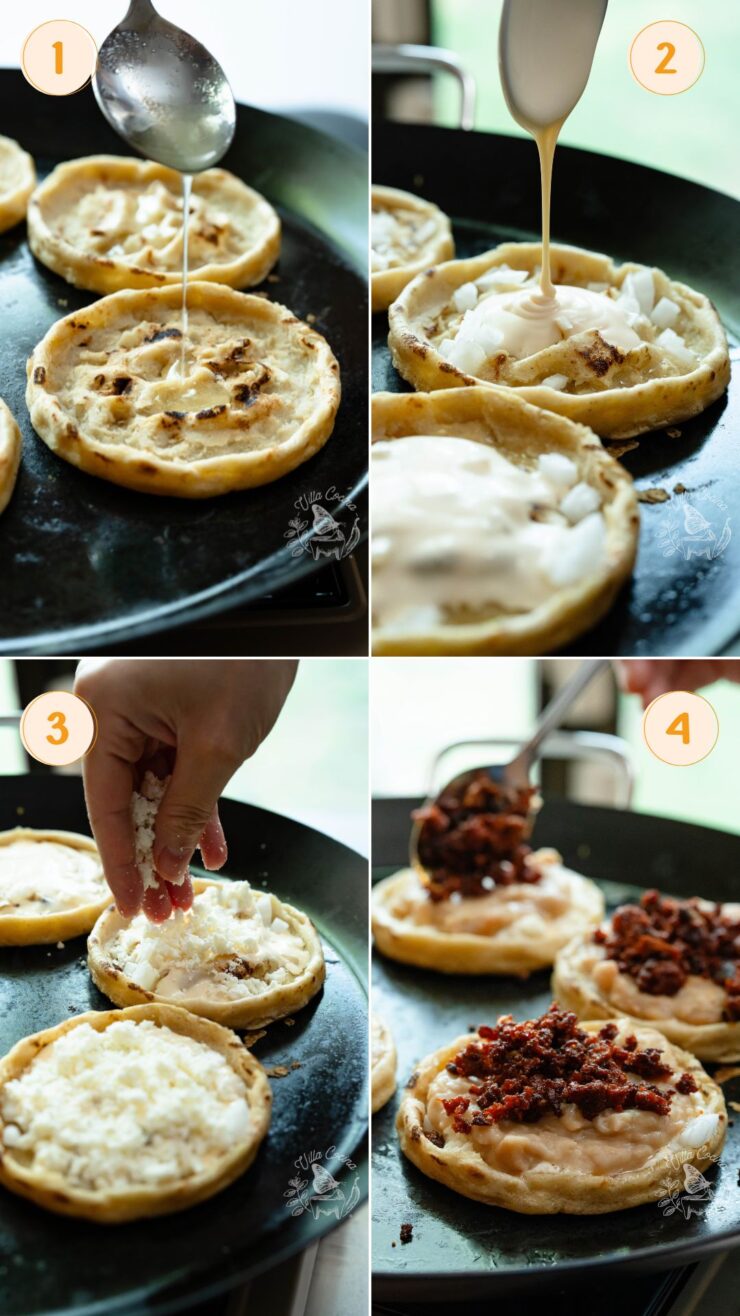
Top with lettuce, tomato, pickled red onions, salsa macha, and cilantro.
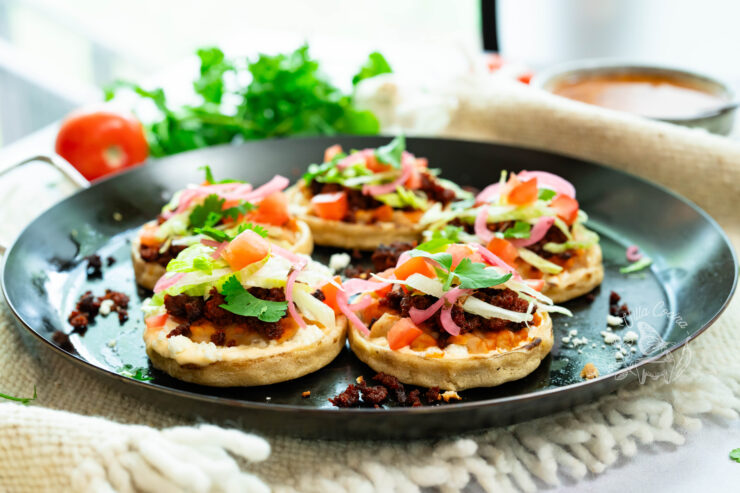
Recipe Video Tutorial
Below is my easy to follow video tutorial on how to make these Mexican Sopes.
Enjoyed the video? Subscribe and tap the bell for updates on new recipes. Thank you for your support!
Choose a salsa!
Selecting a salsa should be a thrilling experience! With diverse flavor profiles and levels of spiciness, everyone’s preferences vary. Here are some options to choose from:
- Salsa Macha (my choice, VERY spicy)
- Green salsa taquera
- Salsa in molcajete
- Golden salsa
- Roasted tomatillo salsa
- Creamy avocado salsa
Make Sopes Using a Plate
Place the disk of dough between two pieces of plastic. Using the bottom of a flat plate, press down until you have a thick tortilla that’s about 1/4 inch in thickness. If needed, smooth the edges.
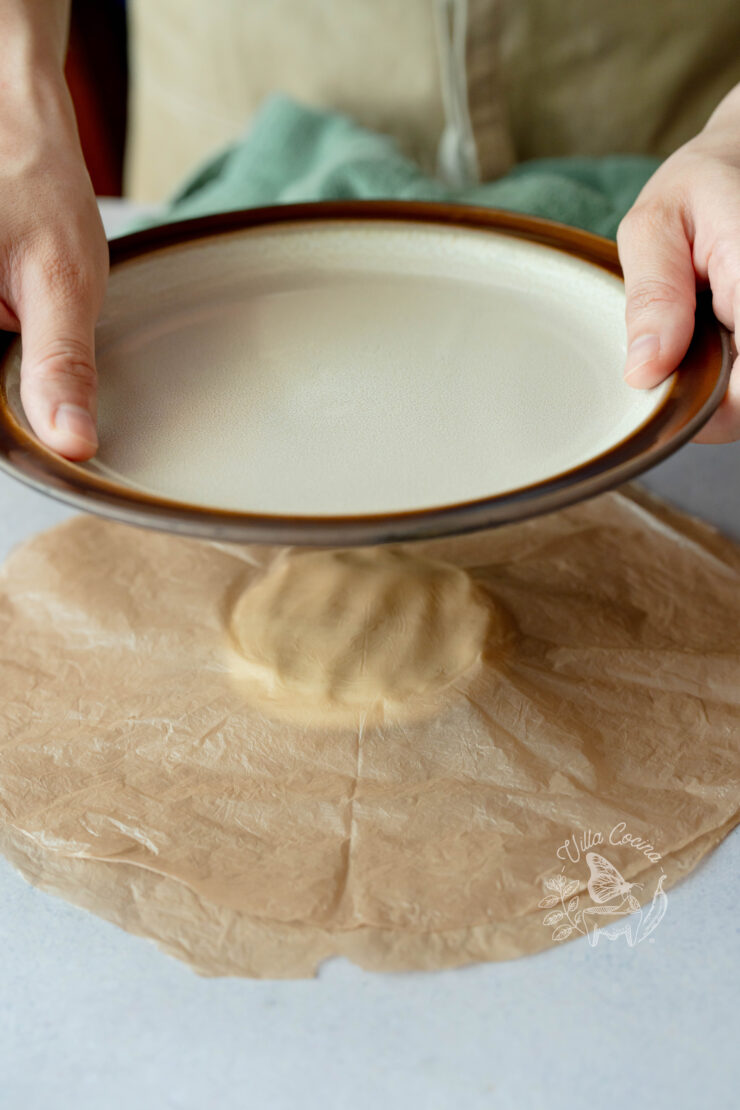
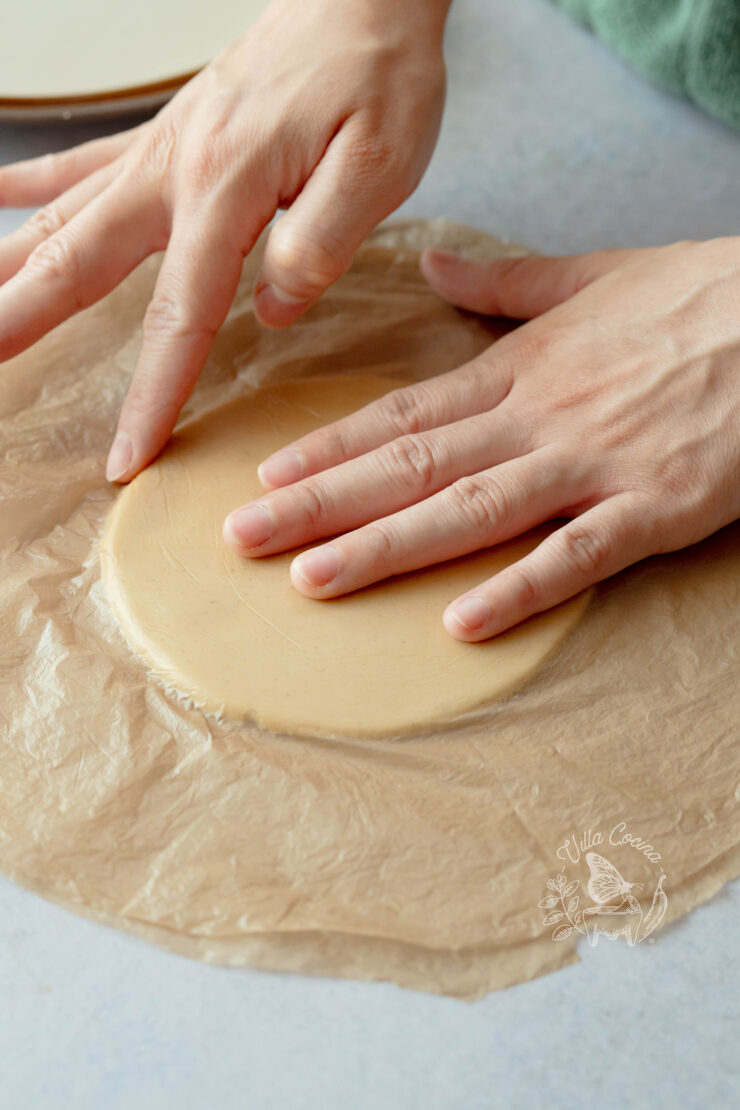
Make Sopes Using a Tortilla Press
Place the disk of dough between two pieces of plastic. Close the press, and carefully press the plates together, ensuring the dough is not too thin. It should be about 1/4 inch in thickness, allowing for easy molding later on.
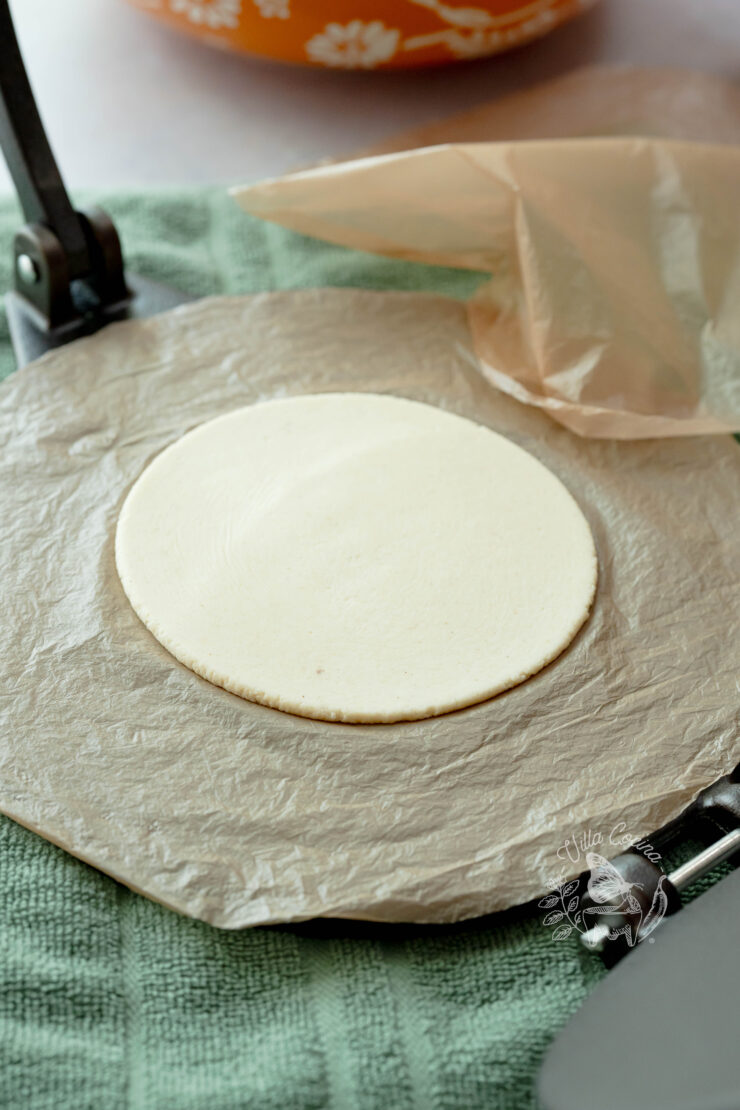
Substitutions
Sopes are incredibly versatile, and you can easily substitute ingredients to suit your tastes. While traditional ingredients yield the most authentic flavors, feel free to experiment and make sopes your own! Here are some substitutions to consider:
- Pork lard – Avocado oil, bacon or chicken fat.
- Chorizo – Beef or chicken.
- Crema Mexicana – Sour cream.
- Cotija Cheese – Queso Fresco or Feta cheese.
- Ice berg lettuce – Romaine or Cabbage.
My Tools for Making Sopes
- Masa harina
For this recipe, I use King Arthur’s Masa Harina, which yields the perfect texture and flavor of traditional Masa. It’s definitely a top favorite!
Another great-tasting brand is Masienda’s Masa Harina, which expertly replicates the authentic flavor of sopes crafted from nixtamalized corn.
- Comal
A traditional Mexican cooking essential that adds a touch of home to any recipe. I highly recommend this Comal from Masienda, which becomes perfect for use after seasoning.
- Tortilla Press
This tortilla press is perfect for any task, and I’ve had so many compliments on it that I’ve even gifted it to my mother, who loves it!
Storing and Reheating
To store sopes, prepare them up to the molding stage (where you pinch the edges and center), then allow them to cool down completely, and store them in an airtight container, where they can be refrigerated for up to 1 week or frozen for up to 1 month in a freezer-safe container.
To reheat sopes, simply heat them over a comal or cast iron skillet, then assemble as usual with lard, sour cream, and cheese. Finally, serve and add your desired toppings. If the sopes were frozen, thaw them overnight in the fridge before reheating.

FAQ: Your Questions Answered
Are Sopes a Mexican street food?
Yes, sopes are a type of Mexican street food that has immense popularity across the country, leading to countless variations and regional twists.
Are sopes only fried?
No, sopes are not only fried. While frying is a common cooking method, sopes can also be baked or cooked on a comal (a traditional Mexican griddle) for a crispy and delicious texture.
What’s Nixtamalization?
Nixtamalization is a traditional process that makes corn softer and easier to grind. It involves soaking and cooking corn in an alkaline solution, then grinding it into a dough called masa.

Perfect Mexican Sopes
Ingredients
Masa
- 3 cups corn masa harina
- 1/2 tsp kosher salt
- 2 cups warm water, plus more if needed
Protein
- 1 lb pork chorizo
Assemble Sopes
- Pork lard, melted
- White onion, diced
- Crema Mexicana
- Queso cotija, crumbled
Toppings
- Refried beans
- Lettuce, shredded
- Tomatoes, diced
- Pickled red onions
- Salsa macha
- Cilantro, chopped
Instructions
Make the Masa – Dough
- Combine masa harina and salt in a large bowl, mixing until well distributed. Gradually pour in the warm water while mixing in between additions with your hands.
- Stop adding water when the dough feels smooth and supple, yet still holds its shape firmly without dry patches.
- Knead the dough for 3-5 minutes until smooth, hydrated, and pliable, but not sticky.
- If the dough feels too dry and cracks, add a small amount of water to restore its pliability and flexibility. On the other hand, if it’s too wet and sticky, mix in a bit more masa harina to absorb the excess moisture, allowing you to mold the sope with ease.
- Cover with a clean kitchen towel or a damp paper towel.
Make Sopes by Hand
- Heat a comal, cast iron griddle, or non-stick pan over medium to medium-low heat. The heat should allow the thick tortilla to cook through and brown, without burning it.
- Divide the dough into 10 equal balls, then flatten each one into a disk by applying gentle pressure and rocking it back and forth between your hands. Continue this motion, rotating and pressing the masa, until you’ve shaped it into a 1/4-inch thick tortilla. If necessary, smooth the edges with your fingers. (Refer to the instructions above for molding the sopes using a tortilla press or plate)
- As you mold each sope, you can either cook it immediately or set it aside to cook all of them later.
- If you choose later, place the molded sopes on a sheet pan lined with parchment paper. Cover them with plastic wrap to prevent them from drying out.
Cook the sopes
- To cook the sopes, start by placing as many as you can on the preheated comal or griddle. Let them cook on the first side, until the bottoms release and develop golden brown spots. Flip them over and cook the other side until equally browned. If needed, flip them multiple times to achieve even cooking and browning.
- Once cooked, remove the sopes from the heat and let them cool slightly while you continue to cook the remaining ones.
Mold de sopes
- To shape the sopes, work with them while they’re still hot, as this will make them easier to mold.
- Wrap your fingers with a kitchen towel to protect them from the heat, then pinch the edges of each sope to create a border. Next, pinch the middle of the sope, taking care not to tear it. Finally, once cool enough to handle, refine the edges with your bare fingers to achieve a more uniform shape.
- Once all the bases are formed, keep them covered.
Protein
- Cook the chorizo in a large non-stick pan over medium heat, stirring occasionally, until fully cooked and crispy. Set aside momentarily.
Assemble Sopes
- Heat a comal or non-stick pan over medium heat. Arrange as many sopes as possible on the hot surface, then add 1 teaspoon of lard and 1 tablespoon of chopped onion. If the bottoms start to get too dark, reduce the heat to prevent burning, allowing them to crisp up.
- Once the fat starts to lightly sizzle (about 5 minutes), drizzle 1-2 tablespoons of crema onto the center of each sope. Top with a generous sprinkle of crumbled cotija cheese and continue cooking until the crema bubbles and the cheese softens, creating a cheesy sauce.
- As the sopes become ready, remove them from the heat and plate them. Spread a layer of refried beans on each one, then top with chorizo, lettuce, tomato, pickled red onions, salsa macha, and cilantro.
Did you make this recipe?
Show some love! Tag @villacocinaofficial on Instagram and drop a 5-star review. Your support means everything—thanks!
